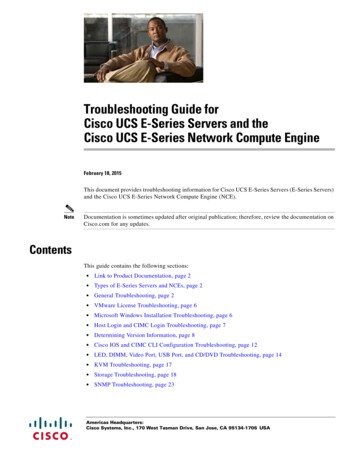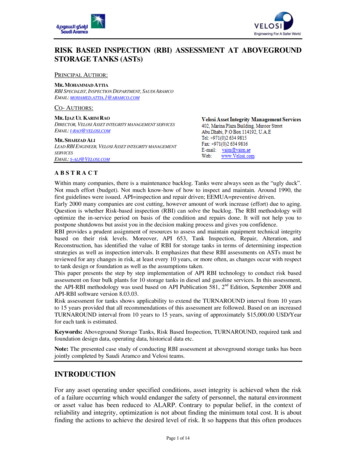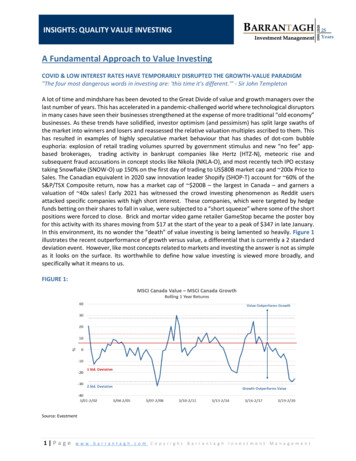
Transcription
Words of Wisdom by Máté MolnárRecovering &Building Value:TurnaroundManagement,Outside Director, &Distressed InvestingStrategiesA Compendium of ArticlesBy John M. CollardContact:John M. Collard, ChairmanStrategic Management Partners, Inc.522 Horn Point DriveAnnapolis, Maryland 21403 rtners.com(410) 263-9100
IntroductionThis collection of writings by John M. Collard is complied as a representative referenceresource of strategies to be successful in the turnaround management, rebuilding value,and distressed investing industry. These articles have been published in many industrypublications and demonstrate the thinking of John M. Collard, an expert turn aroundmanager who runs troubled companies as their CEO, serves as outside director, advisesboards of directors, lenders, lawyers, and private equity investors. There is a turnaround process which involves bringing leadership, setting strategy, building a qualitymanagement team, acquiring new business/sales, establishing sound capital structure,implementing processes, and nurturing resources. Distressed company leadership isabout value preservation, recovery, communicating with multiple stakeholders,rebuilding, saving jobs, and leading in adversity.Enjoy.
Table of ContentsTurnaround Process: Phases and Actions Plan To Improve SuccessManaging Turnarounds Requires Clear Thinking, Quick Action, and a PlanRMA Journal, Publication of the Risk Management Association (Commercial Bankers) 5Managing Turnarounds: Phases and Actions To Accelerate the Recovery ProcessDirectorship, The Magazine of The National Association Of Corporate Directors 9Working With Turnaround Professionals To Preserve ValueRecover & Preserve Value: Working Successfully With Turnaround ProfessionalsPart 1, When is Turnaround Specialist needed? Part 2, How Specialist operatesABF Journal, Turnaround Corner (Asset Based Lenders) 11Early Warning Signs of Companies Heading For TroubleDeathbed Businesses: When a Business Stops Growing. It Starts Dying.Baltimore & Washington Smart CEO Magazines 20Is Your Company In Trouble?The Corporate Board Magazine 22Steering Clear of the BrinkThe Journal of Private Equity, an Institutional Investor Publication 24Building Value In Companies to Prepare Them For SaleA Hands On Approach.Mergers & Acquisitions, The Dealmaker's Journal, SourceMedia, Inc. 28Investing in Underperforming Distressed Troubled CompaniesLooking For The Exit: An Approach To Investing in Underperforming CompaniesDow Jones Bankruptcy Review, Dow Jones & Company Newsletters 30Value Creation Model To Build ValueValue Creation Model. Built to SellShareholder Value MagazineMore 33
Table of Contents (Continued)Defense Conversion — Strategies for Federal Government ContractorsA Director's Guide to Defense Conversion: How to Avoid Minefields in the MarketplaceDirector's Monthly, Strategy Briefs 35Executive Leadership to Enhance ValueAll Leaders Are Not Created Equal: To Save the Company -- Change the Leadership Style 39Director's MonthlyBenefits of Outside DirectorsOutside Directors Offer Valuable Guidance, ContactsBaltimore Business Journal 426 Ways Outside Directors Benefit Business Growth. You Need These GuysPresident & CEO Magazine 43Benefits of Interim Management ExecutivesQuick Leadership & Benefits of Interim Managers. C-Level Execs Make a DifferenceABF Journal, Asset Based Lenders 45Raising Money in Tough TimesRaising Money In Tough Times: Easier Than You May Think.Turnaround Management Journal 48Set Strategy — Building Mission Statement for DirectionMission Possible: Six Questions Your Mission Statement Should AnswerBMDO Update, National Technology Transfer Center 50Incentive-Based Management to Get ResultsIncentive-Based Management: If You Want Results, Show Them The Money! 52Fabricator Magazine, Publication of the Fabricators & Manufacturers Association, International.About the Author: John M. Collard 54Writing Credits 54About the Firm: Strategic Management Partners, Inc. 55Reference Links 56
Strategic Management Partners, Inc.410-263-9100 Page 1 Copyright 2010 by The RMA Journal March 2010, and Strategic Management Partners, Inc.www.StrategicMgtPartners.com (410) 263-9100 Copyright 2010, Strategic Management Partners, Inc.Page 5 of 46
Strategic Management Partners, Inc.By John M. CollardTHERE IS PLENTY of trouble in today’s economy, and few industrieshave been spared hardship. Turnaround opportunities abound for thosewho have the knowledge and fortitude to go through the process. Therewards can be plentiful and the failures catastrophic.The process of turning around a troubled entity is complex andmade more difficult by the multiple constituencies involved, all havingdifferent agendas. Lenders want their invested capital returned, preferably with interest. Creditors want to get paid for goods and services.Original investors want and hope for recovery of their capital, whiledistressed investors want to buy in at 20 cents on the dollar and thenturn a profit, some by trading the credit and others by turning the business positive and then selling. Owners want to avoid guarantees andrecoup some of their equity. Employees want to retain their jobs andbenefits. Directors want to avoid risk and litigation. Other stakeholders want their interests protected. These varied desires often canbe at odds with one another and hamper the turnaround effort.Let’s address the turnaround process as if all constituents favorproceeding through to the end, when a restructured entity emerges,although clearly other scenarios can be envisioned.The High Cost of MismanagementMany causes contribute to business failure. According to a study conducted by the Association of Insolvency and Restructuring Advisors,only 9% of failures are due to influences beyond management’s control and to sheer bad luck. The remaining 91% of failures are relatedto influences that management could control, and 52% are rooted ininternally generated problems that management didn’t control.Businesses fail because of mismanagement. Sometimes it is denial, sometimes negligence, but it always results in loss. Mismanagement is most often seen in more than one of multiple areas: Autocratic management and overextension. Ineffective, non-existent communications. High turnover and neglect of human resources. Inefficient compensation and incentive programs. Company goals not achieved or understood. Deteriorating business and lack of new customers. Inadequate analysis of markets and strategies. Lack of timely, accurate financial information. History of failed expansion plans. Uncontrolled or mismanaged growth.Will Rogers said, “If you find yourself in a hole, stop digging.”It’s good advice for directors and managers with responsibility forleading a company and very good advice for lenders and investors contemplating investing more capital into a troubled entity. This is anopportunity for distressed investors having the “dry powder” to investat bargain rates, the stable of leaders to affect a turnaround, and theknowledge and chutzpah to take on these challenges.The Role of Turnaround SpecialistsTo engineer a successful turnaround, a company needs someone withclear thinking to quickly assess opportunities, to determine what iswrong, to develop strategies that no one has tried before, and to implement plans to restructure the company. The problems are rarely whatmanagement indicates they are, but rather are usually two or three underlying, systemic ills that often can be fixed. You can’t focus on thesymptoms; you must find the real causes. Management has allowedthese problems to exist and bring the company to its depressed state.Therefore, management is not equipped to manage the turnaround.When these circumstances are present, turnaround specialists areoften an excellent choice. They bring a new set of eyes trained in managing and advising in troubled situations. These experts are eitherpractitioners or consultants. Turnaround practitioners take management and decision-making control as chief executive officer or chiefrestructuring officer. As an alternative, turnaround consultants canadvise management, perhaps the same management that failed before. Copyright 2010, Strategic Management Partners, Inc.410-263-9100 Page 2Businesses failbecause ofmismanagement.Sometimes it is denial,sometimes negligence, butit always results in loss.The key to turnarounds is building enterprises in which futurebuyers want to invest. Investors and buyers look for businesses that: Create value and exhibit consistency from period to period. Have a high probability of future cash flows or have a history ofperformance and improvement or the promise of cash. Possess a market-oriented management team with a focus onproducing revenue. Are able to sell and compete; to develop, produce, and distributeproducts; and to thrive and grow as indicated by a track record ordemonstrated changes in the right direction. Exhibit a fair entry valuation and realistic return potential. Have exit options (a high return on investment, or ROI, realizedat time of resale).There is a process of recovery and investment in a turnaround. Itis based on the fundamental premise that management is lacking whencompanies are in trouble. Turnaround specialists must conduct factfinding to assess the situation and then prepare a plan to fix the problems. They must implement the planned courses of action by fundingthe process and building a team to carry it out, then monitor progressand make changes where necessary.Stages in the Turnaround ProcessThe turnaround process has five stages: Management change. Situation analysis. Emergency action. Business restructuring. Return to normal.Let’s look at each stage individually to understand the objectivesand what should be done by each function within the company. Thetiming is important to coordinate what’s happening between functions.Stages can overlap, and some tasks may impact more than one stage.The process is designed to first stabilize a situation, which is doneby addressing management issues, assessing situation, and implementing emergency actions. The restructuring process begins with preparations during the emergency action phase. Positioning for growth startswith restructuring and grows when the normal stage is reached.Management ChangeIt is very important to select a CEO who can successfully lead the turnaround. This individual must have a proven track record and the ability to assemble a management team that can implement the strategiesto turn the company around. The best candidate most often comesfrom outside the company and brings a special set of skills to deal withcrisis and change. His or her job will be to stabilize the situation, implement plans to transform the company, and then hire a replacement.It is essential to eliminate obstructionists who may hamper theprocess. This move could require replacing some or all of top management, depending on the deal. It will undoubtedly also mean replacingsome of the board members who did not keep a watchful eye.Page 6 of 46
Strategic Management Partners, Inc.Management must address issues related to the major stakeholdergroups: executives, function managers, employees, lenders, vendors,customers, and others. To accomplish a turnaround, a company mustmake a concerted effort to change how it operates. Most turnaroundcompanies have a lack-of-sales problem that necessitates a change tojump-start sales and drive revenue. There must be information that allcan rely on for decision making. Production management must support and make what the market wants to purchase at competitiveprices. Management must nurture the critical human capital resourcesthat are left within the company, while at the same time holding themaccountable for results.Changing management is synonymous with changing the philosophy of how a company is run to achieve results. Communication withall stakeholders is paramount throughout all stages of the process. Setgoals that achieve stakeholder objectives, then apply incentive-basedmanagement to motivate the proper results. Tie everyone to the samebroad set of goals and emphasize how functions can complement theperformance of related departments.Situation AnalysisThe objective at this stage is to determine the severity of the situationand whether it can be turned around. Questions to ask include: Is the business viable? Can it survive? Should it be saved? Are there sufficient cash resources to fuel the turnaround?This analysis should culminate in a preliminary action plan stating what is wrong, how to fix it, and which key strategies can turn theentity in a positive direction. There should also be a cash flow forecast(at least 13 weeks) to understand cash usage.Identify effective turnaround strategies. Operational strategiesinclude increasing revenue, reducing costs, selling and redeployingassets, and establishing competitive repositioning. Strategic initiativesinclude adopting sound corporate and business strategies and tacticsand setting specific goals and objectives that align with ultimate stakeholder goals. Too often, goals are misaligned with the ultimate direction and lead to confusion, wasted time, false starts, and employeessent in the wrong direction. Understand that many of the good employees have already left the company. Managements have to work withthe “second string” in the interest of time and build as they go.Understand the life cycle of the business and how it relates to thechosen turnaround strategy. Document key issues so that all partieswill understand what you are trying to accomplish and will pull in thesame direction. Identify which product and business segments are mostprofitable, particularly at the gross margin level, and eliminate weakperformers and nonperformers. Make certain that all functional areasare working to support the goals of their counterparts. Selling workwith flexible delivery times can fill valleys in production cycles, whichreduces costs per unit. Producing only what sales staff can sell to meetcustomer demand will increase sales and gross margin.Turnaround strategies often are affected by local government policy considerations and regulations. In the United States, the WorkerAdjustment and Retraining Notification (WARN) Act requires 60-daynotice of massive layoffs, which certainly impacts cash flow. In manycountries in Europe and the Far East, stringent rules govern payment ofwages after layoffs, as well as dealings with local authorities; someregulations even prioritize which workers can be laid off. When government policy favors labor and employment is not “at will,” there willbe complications.Emergency ActionAt this stage, the objective is to gain control of the situation, particularly the cash, and establish breakeven. Centralize the cash management function to ensure control. If you stop the cash bleed, you enablethe entity to survive. Time is your enemy. Protect asset value by demonstrating that the business is viable and in transition.You must raise cash immediately. Review the balance sheet forinternal sources of cash, such as collecting accounts receivable and Copyright 2010, Strategic Management Partners, Inc.410-263-9100 Page 3renegotiating payments against accounts payable. Sell unprofitablebusiness units, real estate, and unutilized assets. Secure asset-basedloans if needed. Restructure debt to balance the amount of interestpayments with the level the company can afford.Lay off employees quickly and fairly. It is much better to cutdeep all at once than to make small cuts repeatedly. Remaining employees are more likely to focus if they believe their jobs are secure.Rightsizing the company means much more than laying off employees. Correct underpricing of products, prune product lines to onlythose that are profitable and meet demand, and weed out weak andproblem customers. Sometimes too much overhead is applied to support customers that aren’t paying their fair share of that service. Emphasize selling more product at profitable rates. Reward those whochange the situation; sanction or release those who don’t.Business RestructuringIn this stage, the objective is to create profitability through remainingoperations. Stress product-line pricing and profitability. Restructurethe business for increased profitability and return on assets and investments. This is the point at which the focus should change from cashflow crisis to profitability. Fix the capital structure and renegotiate thelong- and short-term debt.Ensure reporting systems put in place are operationalized to showprofitability at each revenue center, cost center, profit center, cash center, incentive center. If employees can’t see it, they can’t manage it.Incentive-based management drives employees to get involvedsmartly and manage to the goals all ascribe to. Create teams of employees to identify and rework inefficiencies and promote profitability.There are only two ways to increase sales: 1) sell existing productto new customers, and 2) sell new products to existing customers. Ifyou want growth, do both.Return to NormalThe goal at this final stage is to institutionalize the changes in corporate culture to emphasize profitability, ROI, and return on assets employed. Seek opportunities for profitable growth. Build on competitive strengths. Improve customer service and relationships. Build continuous management and employee training and development programs to raise the caliber of your human capital.This could be time to restructure long-term financing at more reasonable rates now that the company is stable and on a path to growth.The odds of a successful turnaround increase dramatically if a turnaround phases-and-actions plan is implemented and followed (table).This plan can certainly be adapted to unique situations when required. John M. Collard is chairman of Strategic Management Partners Inc., (www.StrategicMgtPartners.com),Annapolis, Maryland, a turnaround management firmspecializing in interim executive leadership, privateequity advisory, asset recovery, corporate renewalgovernance, and investing in underperforming distressed companies. Inducted into the TurnaroundManagement, Restructuring, Distressed InvestingIndustry Hall of Fame, he is a certified turnaroundprofessional and past chairman of the TurnaroundManagement Association. Contact him atJohn@StrategicMgtPartners.com or 410-263-9100.The RMA Journal is the official publication ofthe Risk Management Association. RMA is aprofessional association whose objective is tofurther the ability of members to identify,assess, and manage the impacts of credit risk,operational risk, and market risk on theirbusinesses and their customers. Serving theFinancial Services Industry.Copyright 2010 Risk Management Association(www.rmahq.org). All rights reserved. Used bypermission of RMA.Page 7 of 46
Strategic Management Partners, Inc.410-263-9100 Page 4Turnaround Phases and ActionsStageObjectivesManagement Change(Leadership) Put top managementteam in place.Situation Analysis(Viability) Can the company survive? Go into survival mode. Should it be saved? Select turnaroundspecialist. Replace some/all topmanagement. Eliminate impediments. Jump-start sales. Drive revenue. Volume in revenue. Get control. Is the business viable? Establish breakeven. Are cash resources Turn cash flow positive.available to fuelturnaround? Raise cash to supportBusiness Restructuring(Change) Create profitability through Seek profitable growth.operations.returns.increased return on assets Build competitiveand investment.strengths.turnaround. Analyze products andservices distribution,sales and marketingstrategies and systems. Protect asset value. Correct underpricing. Prune product lines. Reassess competitive and Explore new markets andproduct line pricing. Weed out weak customers Exploit existing products.and distributors. Develop new products.costs within industryaverage. Sell, sell, sell more. Track cash. Analyze cash flow, Develop trusted reportingand analysis. Emphasize profits and Restructure business for Bring sales and marketing Improve customer andFinancialReturn to Normal(Going Concern) Develop preliminary action Protect resources.plan and nature ofturnaround.Sales and MarketingEmergency Action(Crisis Control)breakeven, profitability,cost reduction, balancesheet, and reportinggross margin by product.distribution mix. Improve sales andmarketing effectiveness. Restructure debt. Improve liquidity. Improve work/capital. Clean up balance sheet. Sell nonproducing assets. Fix capital structure. Reduce cost/ Develop control systems.increase revenue. Eliminate creative Create managerialaccounting system.customer segments. Examine industryrestructuringopportunities. Pursue value-added chainrestructuring. Consider synergisticdiversification. Develop strategicaccounting. Restructure long-termfinancing. Develop stock valuationand buyback system.accounting practices.Manufacturing andProduction Operations Produce to meet saleslevels only. Balance peaks andvalleys. Analyze facilities, Shut down operations.equipment, systems and Reduce work force.procedures, and suppliers. Reduce inventories. Control purchases. Volume out throughput.Engineering, Research Develop new productsand Developmentand services to supportsales. Increase productivity. Analyze new productdevelopment,improvements in product,process, and productivity. Accelerate high-potentialprojects. Shut down tangentialprojects. Unbundle productofferings.Organization Organize for change.Analyze systems: Rightsize the company. Does organizationalstructure make sense? Accounting/Control. Incentive/performancemeasurement andcompensation.Personnel andHuman Resources Hold employeesaccountable. Nurture critical humancapital resources. Slow the turnover rate. Analyze managementteam; sales, finance, andops personnel; recruiting,selection, training,starting, and promotionalsystems. Institute incentive-based Structure turnaroundteam. Review individualaccountability andteamwork. Reward those whochange the situation;release those who don’t. Develop productivityimprovement programs. Reevaluate overhead. Establish ongoing profitimprovement programs. Make new productdevelopment marketand customer–oriented. Build an economicvalue-added orientationinto process engineering. Restructure forcompetitive effectiveness. Develop rewards thatreinforce turnaround. Demonstrate with actionthe seriousness of thesituation. Get peoples’ attention. Improve people mix. Establish who’s in charge. Institute incentive-based Create a professional,management.business-like atmosphere. Bolster people to believein consistent rewardsystem. Sanction nonperformers. Restructure operations forcompetitive advantage. Consider strategicalliances withworld-class firms. Establish advancedtechnology monitoringsystems. Seek competitiveadvantage, strategicleverage in all R&Dactivities. Restructure to reflectchanging strategies. Organize to succeed, thenfill positions with talentedpeople. Don’tcompromise. Institutionalize continuousmanagement andemployee training anddevelopment programs. Grow human assets. Get people to think profit,management.ROI, and cash flow. Copyright 2010 by The RMA Journal March 2010, and Strategic Management Partners, Inc.www.StrategicMgtPartners.com (410) 263-9100 Copyright 2010, Strategic Management Partners, Inc.Page 8 of 46
Managing Turnarounds in Times of CrisisPhases and Actions To Accelerate the Recovery ProcessBy John M. Collard January 15, 2010The process of turning around a troubled entity is complex. Thisis made more difficult and compounded by the multiple constituencies involved, all of whom have different agendas. Directorswant to avoid risk and litigation. Lenders want return of investedcapital, preferably with interest. Creditors want their money inexchange for goods and services. Original investors want andhope for recovery of capital. Owners want to avoid guaranteesand recoup some equity. Employees want jobs and benefits.Other stakeholders want their interests protected. These desirescan often be at odds with other parties and hamper the effort.Address the turnaround process as if all constituents are in favorof proceeding to the end, when a restructured entity emerges.There are many causes that contribute to business failure. According to a study conducted by the Association of Insolvencyand Restructuring Advisors only 9 percent of failures are due toinfluences beyond management’s control and to sheer bad luck.The remaining 91 percent of failures are related to influencesthat management could control, and 52 percent are internallygenerated problems that management didn’t control.Businesses fail because of mismanagement. Sometimes it’s denial, sometimes negligence, but it always results in loss. Mismanagement is most often seen in more than one of multiple areas: Autocratic Management, Overextension Ineffective, Non-existent Communications High Turnover Neglect of Human Resources Inefficient Compensation & Incentive Programs Company Goals Not Achieved or Understood Deteriorating Business, No New Customers Inadequate Analysis of Markets & Strategies Lack of Timely, Accurate Financial Information History of Failed Expansion Plans Uncontrolled or Mismanaged GrowthWill Rogers said, “If you find yourself in a hole, stop digging.”Good advice for directors with responsibility to lead a company.Turnaround specialists are often an excellent choice when thesecircumstances are present. They bring a new set of eyes,trained in managing and advising in troubled situations. Theseexperts are either practitioners or consultants. Turnaround practitioners take management and decision-making control as thechief executive officer or chief restructuring officer. Turnaroundconsultants on the other hand advise management, perhaps thesame management that failed before.The Turnaround Management Association (TMA) was formed in1988 and has grown to 8,600 members around the world whorepresent multiple constituencies working in the industry. TMAsponsors a Certified Turnaround Professional (CTP) programwith strict reference checking requirements and testing of a Copyright 2010, Strategic Management Partners, Inc.Body of Knowledge to become certified. Approximately 500 CTPprofessionals are registered today.The key is to build enterprises that future buyers want to investin. Investors/buyers look for: Businesses that create value. Consistency period to period. High probability of future cash flows. History of performanceand improvement, or the promise of cash. Market-oriented management team. Focus on producingrevenue. Ability to sell and compete; develop, produce, anddistribute products; thrive and grow. Track record or demonstrated changes in the right direction. Fair entry valuation. Realistic return potential. Exit options. Realize high ROI at the time of their resale.There is a process of recovery and investment. It is based uponthe fundamental premise that there is a lack of managementwhen companies are in trouble. You must conduct fact-finding toassess the situation, then prepare a plan to fix the problems.You must implement the planned courses of action by fundingthe process and building a team to carry it out. Then monitor theprogress and make changes where necessary.Stages in the Turnaround ProcessThere are five stages in the turnaround process: ManagementChange, Situation Analysis, Emergency Action, Business Restructuring, and Return to Normality. We will look at these individually to understand what should transpire at each stage byeach function within the company. The timing is important tocoordinate what is happening between functions. Stages canoverlap, and some tasks may impact more than one stage.The process is designed to first stabilize the situation, which isdone by addressing management issues, assessing the situation, and implementing emergency actions. The restructuringprocess begins with preparations during the emergency actionphase. The positioning for growth starts with restructuring andgrows when normalcy stage is reached.Management Change StageIt is very important to select a CEO who can successfully leadthe turnaround. This individual must have a proven track recordand the ability to assemble a management team that can implement the strategies to turn the company around. This individualmost often comes from outside the company and brings a special set of skills to deal with crisis and change. Their job will beto stabilize the situation, implement plans to transform the company, then hire their replacement.It is essential to eliminate obstructionists who may hamper theprocess. This could require replacing some or all of top management depending on the deal. This will undoubtedly mean alsoPage 9 of 46
replacing some of the board members who did not keep awatchful eye.the entity to survive. Time is your enemy. Protect asset value bydemonstrating that the business is viable and in transition.Management must address issues related to major stakeholdergroups (executives, function managers, employees, lenders,vendors, customers, others). There must be change in the focusof how the company will operate to accomplish a turnaround.Most companies have a lack-of-sales problem, which necessitates a change to jump-start sales and drive revenue. Theremust be information that all can rely on for decision making.Production management must support and make what the market wants to purchase, at competitive price. You must nurturecritical human capital resources that are left within the company,while at the same time holding them accountable for results.You must raise cash immediately. Review the balance sheet forinternal sources of cash such as collecting accounts receivable,and renegotiating paymen
Strategic Management Partners, Inc. 410-263-9100 Page 3 Management must address issues related to the major stakeholder groups: executives, function managers, employees, lenders, vendors, customers, and others. To accomplish a turnaround, a company must make a concerted effort to










